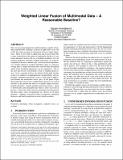Files in this item
Weighted linear fusion of multimodal data - a reasonable baseline?
Item metadata
| dc.contributor.author | Arandelovic, Ognjen | |
| dc.date.accessioned | 2016-10-15T23:34:32Z | |
| dc.date.available | 2016-10-15T23:34:32Z | |
| dc.date.issued | 2016-10-01 | |
| dc.identifier | 245213827 | |
| dc.identifier | 98e9011a-374a-4381-97c6-ddfb73310318 | |
| dc.identifier | 84994634206 | |
| dc.identifier | 000387733800086 | |
| dc.identifier.citation | Arandelovic , O 2016 , Weighted linear fusion of multimodal data - a reasonable baseline? in Proceedings of the 2016 ACM on Multimedia Conference . ACM , New York , pp. 851-857 , 24th ACM International Conference on Multimedia (MM) , Amsterdam , Netherlands , 15/10/16 . https://doi.org/10.1145/2964284.2964304 | en |
| dc.identifier.citation | conference | en |
| dc.identifier.isbn | 9781450336031 | |
| dc.identifier.uri | https://hdl.handle.net/10023/9669 | |
| dc.description.abstract | The ever-increasing demand for reliable inference capable of handling unpredictable challenges of practical application in the real world, has made research on information fusion of major importance. There are few fields of application and research where this is more evident than in the sphere of multimedia which by its very nature inherently involves the use of multiple modalities, be it for learning, prediction, or human-computer interaction, say. In the development of the most common type, score-level fusion algorithms,it is virtually without an exception desirable to have as a reference starting point a simple and universally sound baseline benchmark which newly developed approaches can be compared to. One of the most pervasively used methods is that of weighted linear fusion.It has cemented itself as the default off-the-shelf baseline owing to its simplicity of implementation, interpretability, and surprisingly competitive performance across a wide range of application domains and information source types. In this paper I argue that despite this track record, weighted linear fusion is not a good baseline on the grounds that there is an equally simple and interpretable alternative – namely quadratic mean-based fusion – which is theoretically more principled and which is more successful in practice. I argue the former from first principles and demonstrate the latter using a series of experiments on a diverse set of fusion problems: computer vision-based object recognition, arrhythmia detection, and fatality prediction in motor vehicle accidents. | |
| dc.format.extent | 240715 | |
| dc.language.iso | eng | |
| dc.publisher | ACM | |
| dc.relation.ispartof | Proceedings of the 2016 ACM on Multimedia Conference | en |
| dc.subject | Arrhythmia | en |
| dc.subject | Object recognition | en |
| dc.subject | Computer vision | en |
| dc.subject | Car accident | en |
| dc.subject | QA75 Electronic computers. Computer science | en |
| dc.subject | RA0421 Public health. Hygiene. Preventive Medicine | en |
| dc.subject | A General Works | en |
| dc.subject | NDAS | en |
| dc.subject | SDG 3 - Good Health and Well-being | en |
| dc.subject.lcc | QA75 | en |
| dc.subject.lcc | RA0421 | en |
| dc.subject.lcc | A | en |
| dc.title | Weighted linear fusion of multimodal data - a reasonable baseline? | en |
| dc.type | Conference item | en |
| dc.contributor.institution | University of St Andrews. School of Computer Science | en |
| dc.identifier.doi | 10.1145/2964284.2964304 | |
| dc.date.embargoedUntil | 2016-10-15 |
This item appears in the following Collection(s)
Items in the St Andrews Research Repository are protected by copyright, with all rights reserved, unless otherwise indicated.

